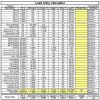When I was going to take up reloading--about 50 years ago, I bought a Lyman Manual to read up on it. Their section on cast bullets perked my interest. When I got to the making Lyman#2 etc I got confused. How do you take 90-95% unknown wheelweights and add 5-10% exacts and come up with an exact? What if the ww's already had some of this stuff? I was just going to be plinking with them and if it took more than one shot to kill a beer can, no big deal, they weren't shooting back. Now I have had beer cans kick my butt, but that's another post.
I'll admit that I don't plink with such precision that I can detect a difference in BHN as obviously some of you can do. I also can't shoot well enough to detect a few grains difference (very small percentage wise) in bullet weight. I'm not going to be shooting matches against you anyways, so I don't worry about my deficiency. How could I possibly consider shooting against such precision? I didn't plan on landing any of my shots on the moon so rocket science wasn't in the equation. I did try to do it once, but in my unscientific methods, I overshot it.
With this mindset, I just used plain wheelweights and I think they work well. Many, many years later when I started casting .22 cal for use in rifles, I was told by lots of folks I needed to add tin to get good fillout. I bought some tin which was the only alloy I have ever bought and ONLY difference I could tell was in my wallet.
But how could I join in on a forum such as this and have anything to add if I was so plain? So I developed a formula. Didn't want to be left out of the conversation. Here it is. You take 50% free wheel weight and carefully weigh them. Then you take that exact amount of wheelweights you didn't have to pay for. Blend the two. I heard that if this is done when there is a quarter moon it works better, but to me results really seem the same if a full moon, harvest moon, half moon, blue moon, or done during the day. BTW except for that tin I've never bought alloy. I can still get free wheelweights at a few places. That's my story and I'm sticking to it.



